Published
on 6
Dec 2023
|
All rights reserved.
|
|
|
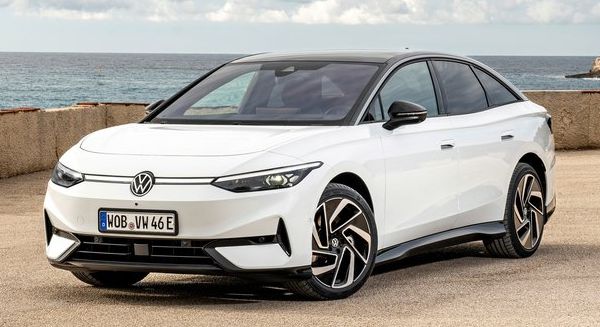
|
|
ID.7
is an E-segment car, both in size and price.
|
|
Just a few years ago,
Volkswagen was still the world’s most powerful automotive manufacturer.
Cars like Golf have been seen as the standards of the world, thanks to
superior build quality and engineering excellence driven by former boss
Ferdinand Piech. You can still feel his influence to Volkswagen’s
products many years after his retirement. However, the “Dieselgate”
scandal happened in 2015 was the turning point of its fate. In the
following decade, Volkswagen group paid heavy fines and compensation.
New boss Herbert Diess wanted to reboot its image by abandoning
combustion engines and switching to electric cars early, which sounded
smart at the time, but he lacked the skillset to execute the
transformation. If you read his CV, you will find Diess is a
“production guy” rather than a “product guy”, in contrary to Piech. How
to streamline production, use more common parts and reduce inventory
are what he concerns. Whether the car looks great, feels good and
drives well, he has no idea. No wonder the first wave of Volkswagen ID
electric cars flopped. They look boring outside, cheaply finished
inside, and the driving experience is seriously hampered by poor
ergonomics and software glitches that ruined the reputation of ID.
Moreover, its 400V electrical architecture with 170kW maximum charging
rate is hardly state of the art. How can it beat Tesla, Hyundai-Kia and
the rising Chinese manufacturers?
Maybe Volkswagen saves the best for the last? 3 years into the program,
the ID family finally expands to the top of the range. ID.7 is a large
family sedan – well, a sedan-looking hatchback. Measuring 5 meters in
length, 1.86m across shoulders and over 1.5m tall, it is a full size
larger than Passat and goes straight to the E-segment. Burdened by
underfloor batteries, it weighs a substantial 2097 kg in single-motor
form. Upgrade to long-range battery and dual-motor power and I can’t
imagine… The price tag reflects its higher market positioning, too – it
starts at £56,000, a full £20,000 more than the old Passat.
This put it in the territory of BMW 5-Series or Mercedes E-class, if
not the electric i5 and EQE. No wonder Volkswagen mentioned the word
“Premium” repeatedly.
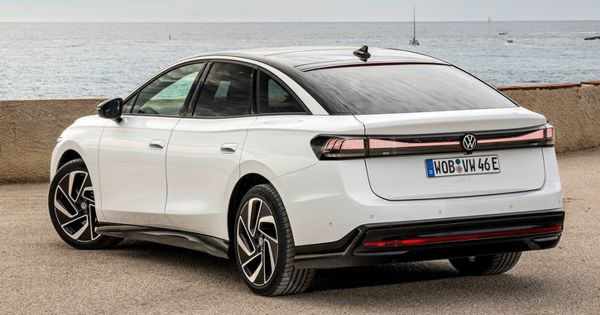
|
|
The
flowing waistline looks 4 inches taller than it should.
|
|
Despite its premium pretension, the ID.7 still rides on the same MEB
platform of ID.3, ID.4, ID.5 and ID.6. This means the electrical
architecture is still 400V, while maximum charge rate is 170kW for
standard battery or 200kW for long-range battery.
The ID.7 shares many genes with its siblings. This starts from a bulky
proportion, which is undoubtedly the result of a thick skateboard
floorpan. Volkswagen’s designers try to make it less boring by using a
flowing waistline, but still, the waistline looks 4 inches taller than
it should. The result is like a fat woman trying to play Audrey
Hepburn’s role in My Fair Lady. It just won’t work!
But the problem goes beyond the waistline. The ID.7’s exterior styling
lacks character. It just tries to wrap the required volume with a shape
that generates the least drag (Cd 0.23) to optimize range, without
thinking too much about character. Volkswagen group’s design talents
have been declining for a long time, but I am not sure when it will
bottom out. Even Chinese manufacturers can draw more interesting cars
these days.
The ID 7 keeps the packaging flaws of all MEB cars, most notably a lack
of front luggage compartment and a shallow rear boot. Thanks to a
massive, 2970mm wheelbase, six-footers can sit behind another
six-footers without compromise, which is admittedly a must for an
E-segment car. However, as there is no space left under the front
seats, rear legroom is not as generous as the long wheelbase would have
you believed. Moreover, because of the raised floor, you sit higher
than in conventional sedans, so the roof feels a little too close to
your head. That means the optional Panoramic glass roof worthwhile to
take, because it releases a little more headroom and make the cabin
feels airier. Electrotranslucent technology can turn the glass to dark.
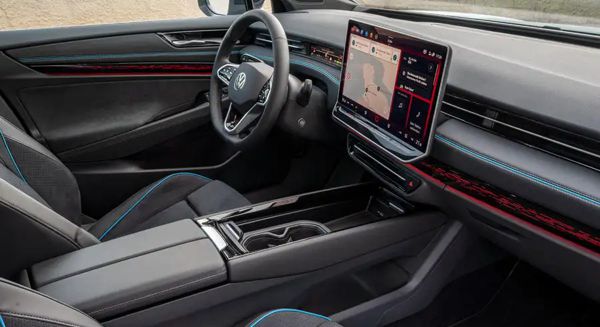
|
|
Ergonomics
are improved but still leaves something to be desired.
|
|
The cabin design of ID.7 is just as boring as outside. There is a tiny
digital instrument in front of the driver, but most functions are
displayed in the 15-inch touchscreen. Volkswagen talked of improved
ergonomics, but cost saving is still put before ease of use, as there
is virtually no physical switches left. The haptic touch controls on
the steering wheel
are still easily touched by accident. The notorious “slider” touch
control bar located below the touchscreen is still annoying to use,
even though it is now backlit in dark. Yes, the infotainment system
gets more responsive, and the user interface has been redesigned such
that most frequently used functions can be found on the home screen,
taking no more than 2 taps to activate, but it is still less intuitive
than good old switchgears. You know, for 2 or 3 decades Volkswagen has
been known for tactile-feeling switchgears. Abandoning its strength and
mirroring Tesla is just like committing suicide. Replacing half of the
soft-touch plastics mandated by Dr. Piech with hard and scratchy ones
is another foolish act, especially for something sold at 5-Series
money. If Dr. Piech was still alive and overseeing Volkswagen, I am
sure these disasters won’t happen.
In fact, the mediocre thinking is obvious throughout the car. The base
ID.7 runs a single motor at its rear axle that pushes out a quite
remarkable 286 horsepower and 406 lbft of torque, but with a lot of
weight to haul, it is neither quick nor slow, taking just over 6
seconds to go from 0-60 mph. Top speed is limited to 112 mph like
Volvo, so stick to the slow lane on Autobahn. If you want more punch,
there will be a dual-motor GTX model, expected to offer 340 hp.
However, judging from the ID.4 GTX you’d better to forget about it.
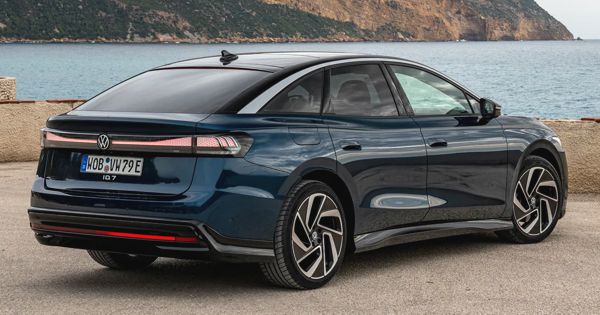
|
|
Mediocre
thinking is obvious throughout the car.
|
|
As for ride and handling, the ID.7 is again neither good nor bad. In
Volkswagen’s fashion, it offers decent body control and grip and a
secured driving manner. The steering is devoid of feel but weighs up
linearly. The lack of engine up front allows the front wheels to turn
more, hence a surprisingly tight turning circle for its size. Push
harder, the car is default to understeer, but the rear-drive chassis
allows to tighten the line with throttle, although stability control
will intervene early to kill any hope of power slide. The brake pedal
feels artificial, and you cannot control the level of regenerative
braking.
Ride comfort is generally good, as soft springs are matched with DCC
adaptive dampers. However, larger bumps are not quite as well dealt
with, while noise insulation is not as good as a premium car should.
The ID.7’s biggest strength is range. Its standard battery has 77 kWh
net capacity (82 kWh gross), while long range battery is 86 kWh net (91
kWh gross), larger than most rivals. Coupling to a rather low drag
coefficient, they offer class-leading range, 382 miles (615 km) and 435
miles (700 km) on WLTP cycles respectively.
However, apart from range, there is hardly anything mark it out from
the competition. The ID.7 is hard to love. It is not pretty. It is not
particularly roomy or premium-feeling. Neither it is fast nor memorable
to steer. Ergonomics shortfall still catch it out somewhat. Moreover, a
starting price of £56K is way more than you would expect for a
Volkswagen EV. Herbert Diess has gone, but his influence to
Volkswagen’s EV plan will take years to wane.
|
Verdict:    |
Published
on 22
Aug 2024
|
All rights reserved.
|
|
| ID.7 GTX |
|
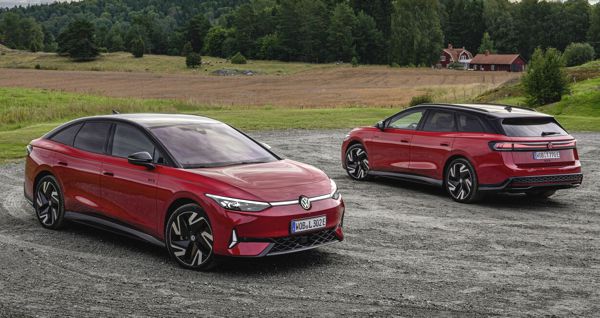
|
|
Not
exactly a performance model, but the best of all ID.7 models.
|
|
Originally the GTX
sub-brand was supposed to be the equivalent of GTI in Volkswagen’s
electric line-up. However, from the concept you can already see it is
not going to work. A GTI is GTI because it is light, simple and agile.
Quite powerful for its weight, too. In contrast, the GTX models of ID3,
ID4, ID5 and ID Buzz are all heavy, secured to steer but short of
driver engagement, blame to their twin-motor and 4WD setup. They are
not very powerful for their weight either, lacking the sparkles of
traditional GTIs. In addition to elevated prices and reduced range,
they are hardly desirable choices among the ID cars.
The GTX version of ID.7 is no GTI either, but it is probably the most
satisfying GTX model to date. That’s not to say it is fun to drive, but
it is simply a better ID.7. While the standard ID.7 is a sensible large
family car offering vast of space and outstanding range, it is a bit
slow for an electric one, taking over 6 seconds to do 0-60. Its chassis
setup is heavily oriented to comfort and refinement, and that prevents
it from stealing sales from BMW etc. The GTX just corrects the wrongs
of the standard car, shifting the ID.7 to the middle of the ground in
the E-segment.
The majority of its propelling power still comes from the 286 hp / 402
lbft APP550 rear motor, but the front axle is added with a 109 hp / 99
lbft AKA150 motor. Unfortunately, the battery limits total output to
340 hp, so the GTX is not going to challenge the fastest Teslas or
Chinese-built EVs. Still, 0-60 taking 5.1 seconds is a welcomed
improvement, and honestly plenty quick for a large family car. Note
that the front motor is induction type, thus when not in use it can be
de-energized to reduce power consumption, unlike a permanent magnet
motor. That said, equipped with the long-range battery (91 kWh gross)
already available to the lesser ID.7, the GTX travels 71 less miles on
a charge than the standard car, although at 370 miles it is still ahead
of the single-motor BMW i5 eDrive40.
Apart from more speed, the GTX also has its adaptive suspension,
anti-roll bars, steering and electronics recalibrated. As a result, the
steering gets more direct and responsive. Body roll is reduced, yet
ride quality is not severely damaged, even on the optional 21-inch
wheels. Refinement is still one of its strongest cards. There is more
grip and traction generated by the 265mm rear tires. In short, the
softness of the standard car is largely abandoned, making it a better
car overall.
That said, on twisty roads the car’s 2.3-ton weight is still obvious.
The long and vague brake pedal is also carried over from the standard
car, preventing the ID.7 from challenging lighter ICE rivals. However,
if you cross-shops only electric cars, it has very few rivals. The
aforementioned i5 eDrive40 is the closest, but the Volkswagen undercuts
it considerably in price. A Mercedes EQE is even more expensive.
Hyundai Ioniq 6, Jaguar I-Pace and Polestar 4 are all smaller and less
value-packed. The ID.7 GTX is also available with wagon body at just a
slight premium, making it the most sensible choice, if not the most
desirable.
|
Verdict:    |
|